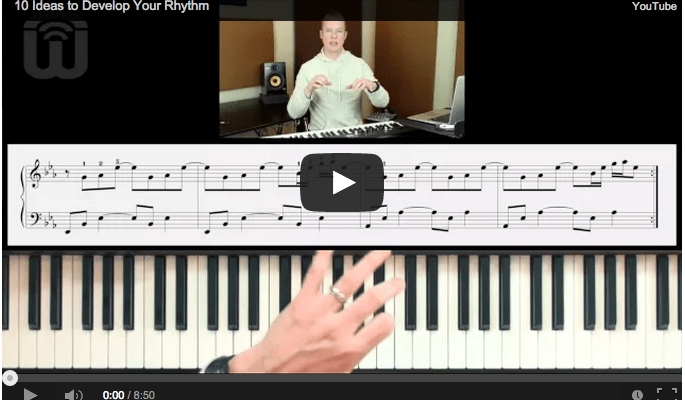Ten ideas to develop your rhythm

From my spot in the horn section, I watched and admired the rhythm guitarist. He was grooving away on sixteenth notes, each strum right in the pocket. It sounded and felt right – good and locked in.
At the end of rehearsal he walked over and asked, “Are you hearing enough drums in your monitor?”
I quickly responded, “Yeah, I think we’re good.”
After a minute, I realized I was being obtuse. The guitarist (who was also serving as the music director that day) wasn’t concerned with the balance of my mix. He was really implying, in a really polite way, that my rhythm was off.
I’ve always been musically inclined, but rhythm is something I’ve had to develop. Here are ten things that have helped me; perhaps you will find them useful as well.
1. Practice with a metronome
There’s no better way develop even tempo than playing with a metronome. The feedback it gives you is brutally honest – you’re either with it or not. If you don’t have a dedicated metronome, you might find a smartphone app or simply search for an online metronome.
2. Practice with drum loops
If you can’t stand metronomes, use drum loops, such as those in GarageBand or other music software. Loops can be more fun than metronome clicks. They can also help you develop a groove to your playing.
3. Subdivide the beat
The best way to maintain a steady tempo on your own is to feel the subdivisions of the beat. For example, don’t focus just on the quarter notes, but keep an internal feel with the eighth note or sixteenth note subdivisions. If you’re successfully aligning rhythms with your internal clock, you’ll be surprised at how much more accurate your tempo becomes.
4. Find your spot in the pocket
Rhythm doesn’t always feel best when it’s perfectly on the beat. Sometimes the human element creates variations that are slightly ahead of or behind the beat. When these variations fall in a desirable place, musicians call it being “in the pocket.” Once you’re comfortable with even tempo and feeling the subdivisions, begin to experiment with playing around the beat – a little ahead or behind. For example, a bass guitarist playing slightly ahead of the beat can drive the music forward, while a snare hitting slightly behind can sweeten the groove.
The first four ideas focused on playing your rhythms in time. The last six deal with conceiving rhythms to play.
5. Balance repetition and variation
Repetition in music gives a sense of stability, while variation lends interest. When you’re creating your own rhythms, create a stable foundation by repeating a primary rhythm. Then add variations to keep things interesting.
6. Utilize syncopation
Syncopation means playing an emphasized note in a weak part of the measure. There are two main types: eighth-note and sixteenth-note syncopation. Eighth-notes are typically counted “One-and-two-and-three-and…,” so eighth note syncopation would place an emphasized note on an “and.” Sixteenth-note (“One-ee-and-uh, two-ee-and-uh…”) syncopation would emphasize an “ee” or an “uh.”


7. Let both hands create rhythm
If you’re a keyboard player, you have the advantage of creating rhythms with both hands. For example, you can use your left hand to to fill in notes between your right hand rhythms.
8. Hemiolas
A hemiola is a three-beat pattern played against a two- or four-beat structure. It sounds cool because it creates repetition and variation at the same time. Each time a hemiola repeats, it starts at a different place. For example, a three-beat pattern in a song with four-beat measures would start on beat one, then beat four, then three, then two.
9. Don’t use triplets
They’re the worst.
10. Don’t discount the value of space.
For all these tips about rhythm, sometimes the best idea is to use none of them. Give listeners time to let the power of what you’ve already played sink in. It takes time to appreciate awesome.
[shameless plug] My Fluent Piano Video Course will help you a lot with your rhythm. It has metronomes, drum loops, syncopation, repetition/variation, and the best part is, no triplets anywhere! Try the first two sessions for free at this link.

